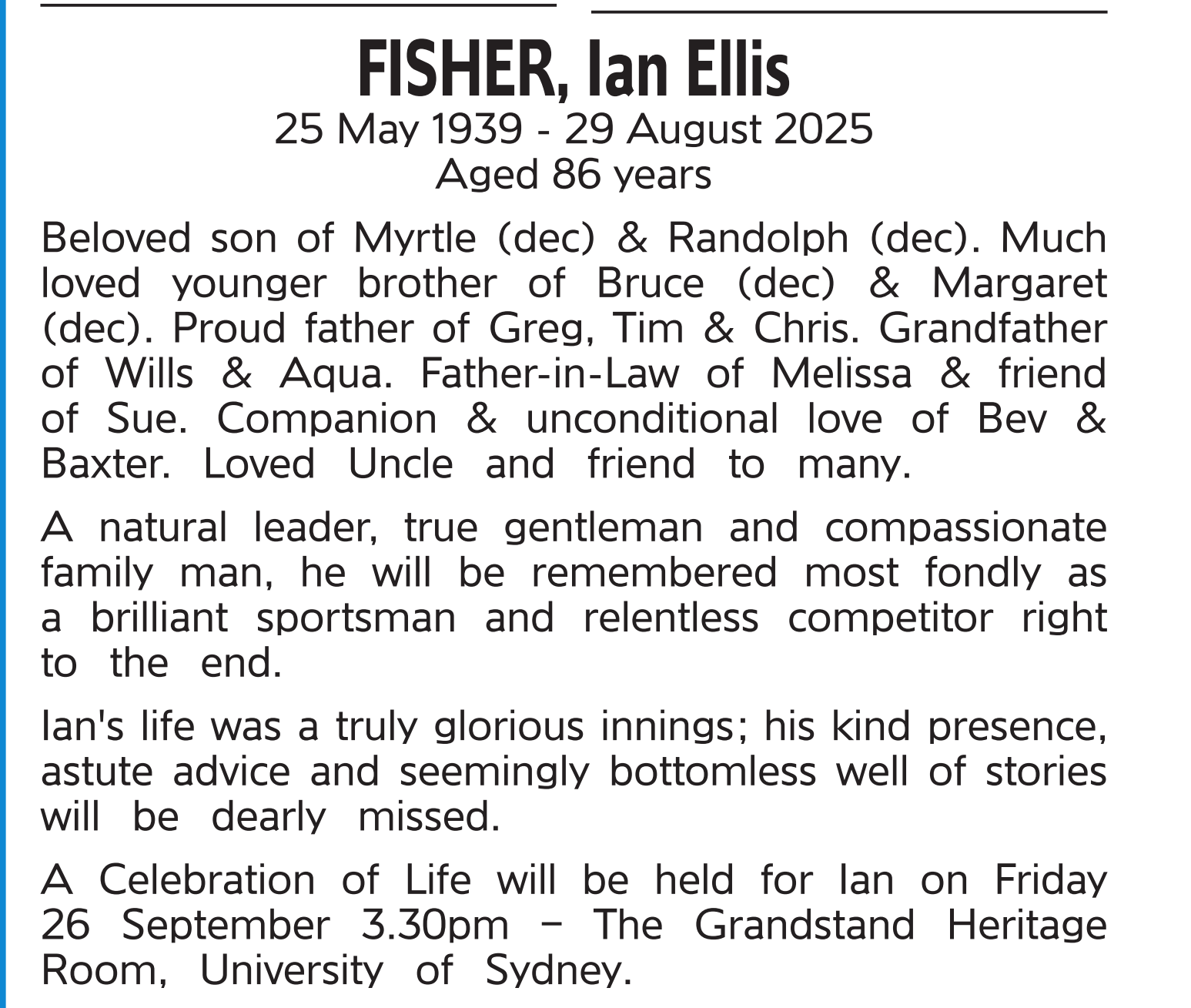A tribute from John Rogers who played against Ian Fisher and who has fond memories.
The Ian Fisher “chin”.
It spoke: “battle joined!” And did Fish like a battle.
Yes, it’s an old saying about famous people sticking their chin out when situations got tough. Fish’s though, was not a showy, “I’m going to fix you”, exercise of people sticking their chin out trying to intimidate.
When stirred, Fish’s chin seemed to grow out of his round, Welsh-style face. Involuntarily. Whenever I saw it, I knew my team was in trouble, To back it up, his eyes would positively gleam. And when something happened that he didn’t like, the chin was re-doubled.
I first noticed it when my all-powerful St George team was winning a hat-trick of Sydney 1st Grade Premierships. We’d unearthed a young spinner who before he was aged 20 had taken more wickets in Sydney grade than anyone of that age had ever done before. Kerry O’Keeffe. The same Kerry O’Keeffe used to say he had nightmares about bowling to Ian Fisher. He’d have a couple of wickets up his sleeve and in would come Fish. A few balls later there’d be a little skip down the pitch, the beautiful sound of the middle of a cricket bat hitting a cricket ball, and very soon afterwards the sound of a cricket ball crashing into a picket fence wide of wide of long-on. In mid-pitch, the head of I Fisher would swing around, eyes a-gleam, chin out, eye-balling everyone, as if to say: "bring it on!"
A few weeks back, Paul Ryan on his Cric-Connect website asked for opinions of the one Sydney Grade player who should have played for Australia? “Ian Fisher”, I’d decided after a day of consideration. A couple of NSW captains in Warren Saunders and Siddy Carroll, plus the astonishing Neil Marks (of hole-in-the heart operation fame), were my initial thoughts. “Fish” hadn’t even made the NSW side, unlike the others. But he would still have been my pick. Les Johns, champion footballer, might have run him close. Both in the middle-order would have had the same toughness of Allan Border and Steve Waugh.
In my first year of captaining St George, I came up against Fish captaining Sydney Uni on our home ground at Hurstville. I had a good day, I’d scored a very rare century. As usual both teams had a drink afterwards. Perhaps I was a bit cock-a-hoop. Fish, I could see was displeased. When Uni batted next week, Fish scored 120 to win the game. Trumped me. That chin annoyed me all afternoon. I was less cock-a-hoop that evening.
Fish was an unfashionable player in an era when NSW was expecting superstars to arrive on the scene as if by divine right. Keith Miller had held the stage and what a superstar he was as captain. He started a run of nine Sheffield Shield titles in a row. Young superstars appeared from everywhere. O’Neill and Walters were perhaps the last. Then it dried up. In the late 1960s, the wheels had fallen off for NSW, partly because any shiny new kid with a few runs was given a go. Squat, tough, serious Fish, playing always in struggling teams, was never given a thought. He crouched at the crease, refused to play flashy drives and seemingly muscled bowlers to the fence around point and square leg. Charismatic was not a word used to describe batsman Fish. And few realised how deceptively fast he was in the field.
I saw that chin at tennis too. In the mid 1970s, we both joined the tennis club that played on the three grass courts at the back of the Noble Stand at the SCG. We became part of a team that included Tests stars Ian Craig and Frank Misson plus the inimitable David de Carvalho. We had a great time. We played tennis together as if we were playing in the same cricket team. I’d been a promising junior with plenty of style. Fish, I thought was okay, but had no spin, a poor serve and no style. After five years of playing together, I moved to Perth where I began to play tennis quite seriously and improved sufficiently to make the no.2 side for WA in national seniors events. Most years I would travel to the national titles in Gold Coast, Newcastle. etc. One year I was surprised to bump into Fish. His partner Bev, he told me was a very good player had encouraged him to play more competitively. So you're here to watch Bev?” I asked. “Yes," he replied, “But I’m also playing in the NSW no.1 team (of 4 players) in the over 50s”.
Disbelieving, I went to watch. His partner, I remembered for being a real star in junior days, still with a wonderful kick serve and topspin on both sides. Fish was the same Fish. Poor serve, no topspin, no style. Their Q'ld opponents were big, skilful, fast and aggressive. I could see the Q’lders eyeing off Fish as the one to attack. The Q'lders lost. Best player on the court was Fish. Didn’t miss a thing. Returned every serve. Softly tapped his own serve, followed it in, half-volleyed unerringly, played dinks and lobs, and put away volleys when required. As he survived another barrage, and dispatched a volley to win the point, I saw him turn towards his partner with chin out and eyes a’gleam. Exactly the same as when he batted. And he stayed in that NSW no.1 team for the next 15 years or more. in 2009 he brought his older sister Margaret along. He'd persuaded her to take up tennis at aged 79 after 20 years away from the game. He added quietly that she’d played at Wimbledon in 1953. Whaaaat? She would win a world over-80s title. Full of surprises was Fish.
Graham McEachran over in WA has often told this story.
Fish captained the 1976 Australian Old Collegians cricket team on its regular 4-yearly, round-the-world tour. It was full of good quality Sydney Grade and country cricketers, it was scheduled to play the Surrey county, 2nd X1 team. A recent wash-out meant that wanting practice,Test star John Edrich turned up with most of the first (County) team – Alan Butcher, Alan Jackman, Geoff Arnold, Pat Pocock, Mickey Stewart, Younis Ahmed - all test players. Before the game Edrich came into the AOC dressing room and said: "Ian, we don’t need to toss, do we, I mean we’ve only come for batting practice, so we’ll bat?” Fish suggested that perhaps they should go out, look at the track and toss, which they did. Fish then won the toss but, and before he could say anything, Edrich chimed in with “Ian, I know you’ve won the toss but you won’t mind if we bat, will you, as we’ve only come for batting practice?” Fish replied: “that’s all right John, you can bat ……… after us.” We lost early wickets but then Fish had a big partnership with Sydney Uni allrounder Rob Woodhouse, who got 70-odd while Fish got around 150, smashing this test attack everywhere. Eventually Edrich started saying things like “Ian, you’re not going to bat much longer are you? I mean we’ve only come for batting practice!” Well Fish finally declared – but during the change of innings, the heavens opened, the game was washed out and Edrich never got his batting practice – in the middle of the driest summer in English history!”
Our friendship started back in 1963 when he was playing with the old Glebe club. He phoned me, in mourning, when his club-mate Frank Misson died a year ago. Just a month back on email, I told him i had a recollection that in the 1970s, he’d worked for a NZ construction company called Fletchers. He replied: “Fletchers - I had forgotten all about them. Was Project Manager on the “Airport Hilton” at Arncliffe and then Project Development Manager." What he did after that, I've no idea. But I do remember him visiting Perth managing a NSW Sheffield Shield team, when he was a state selector. We swapped stories about helping uni cricket clubs, and gradually I learned how revered he was at Sydney Uni.
RIP Fish. Such an underrated cricketer - though not by opponents. Amazing tennis player. Great companion. I shall miss him.
John Rogers








